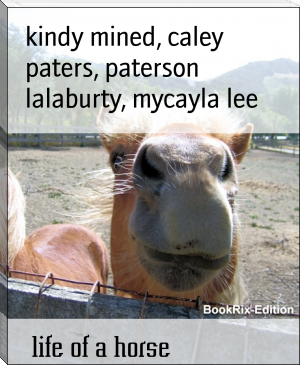Wild Beasts and Their Ways, Sir Samuel White Baker [books successful people read TXT] 📗

- Author: Sir Samuel White Baker
Book online «Wild Beasts and Their Ways, Sir Samuel White Baker [books successful people read TXT] 📗». Author Sir Samuel White Baker
CHAPTER I
THE RIFLE OF A PAST HALF CENTURY
Forty years ago our troops were armed with a smooth-bore musket, and a small force known as the "Rifle Brigade" was the exception to this rule.
The military rifle carried a spherical bullet, and, like all others of the period, it necessitated the use of a mallet to strike the ball, which, being a size larger than the bore, required the blow to force it into the rifling of the barrel in order to catch the grooves.
Sporting rifles were of various sizes, but they were constructed upon a principle generally accepted, that extreme accuracy could only be obtained by burning a very small charge of powder.
The outfit required a small mallet made of hardwood faced with thick buff leather, a powerful loading-rod, a powder-flask, a pouch to contain greased linen or silk patches; another pouch for percussion caps; a third pouch for bullets. In addition to this cumbersome arrangement, a nipple-screw was carried, lest any stoppage might render necessary the extraction of the nipple.
The charge of powder in ordinary use for a No. 16 bore (which carried an ounce spherical ball) was 1 1/2 dram, and the sights were adjusted for a maximum range of 200 yards. Although at this distance considerable accuracy could be attained at the target upon a quiet day, it was difficult to shoot with any precision at an unmeasured range owing to the high trajectory of the bullet. Thus for sporting purposes it was absolutely essential that the hunter should be a first-rate judge of distance in order to adjust the sights as required by the occasion. It was accordingly rare to meet with a good rifle-shot fifty years ago. Rifle-shooting was not the amusement sought by Englishmen, although in Switzerland and Germany it was the ordinary pastime. In those countries the match-rifle was immensely heavy, weighing, in many instances, 16 lbs., although the bullet was exceedingly small.
The idea of non-recoil was paramount as necessary to ensure accuracy.
It will be at once perceived that the rifle was a most inferior weapon, failing through a low velocity, high trajectory, and weakness of penetration.
In 1840, I had already devoted much attention to this subject, and I drew a plan for an experimental rifle to burn a charge of powder so large that it appeared preposterous to the professional opinions of the trade. I was convinced that accuracy could be combined with power, and that no power could be obtained without a corresponding expenditure of powder. Trajectory and force would depend upon velocity; the latter must depend upon the volume of gas generated by explosion.
The rifle was made by Gibbs of Bristol. The weight was 21 lbs., length of barrel 36 inches, weight of spherical belted bullet 3 ounces, of conical bullet 4 ounces, charge of powder 16 drams. The twist was one full turn in the length of barrel. The rifling was an exceedingly deep and broad groove (two grooves), which reduced the difficulty of loading to a minimum, as the projecting belt enabled the bullet to catch the channel instantly, and to descend easily when wrapped in a greased silk patch without the necessity of hammering. The charge of powder was inserted by inverting the rifle and passing up the loading-rod with an ounce measure screwed to the end; this method prevented the powder from adhering to the sides of the barrel, and thus fouling the grooves.
An extraordinary success attended this rifle, which became my colossal companion for many years in wild sports with dangerous game. It will be observed that the powder charge was one-third the weight of the projectile, and not only a tremendous crushing power, but an extraordinary penetration was obtained, never equalled by any rifle that I have since possessed.
This weapon was in advance of the age, as it foreshadowed the modern Express, and the principle was thoroughly established to my own satisfaction, that a sporting rifle to be effective at a long range must burn a heavy charge of powder, but the weight of the weapon should be in due proportion to the strain of the explosion.
When I first visited Ceylon in 1845, there were several renowned sportsmen who counted their slain elephants by many hundreds, but there were no rifles. Ordinary smooth-bore shot-guns were the favourite weapons, loaded invariably with a double charge of powder and a hardened ball. In those days the usual calibre of a gun was No. 14 or 16. A No. 12 was extremely rare. The charge for No. 16 was 2 3/4 drams of fine grain powder, and drams for No. 12. Accordingly, the light guns, or "fowling-pieces," as they were termed, were severely tested by a charge of 6 drams of the strongest powder with a hardened bullet; nevertheless I never heard of any failure.
At a short range the velocity and penetration of an ounce spherical ball, with the heavy powder charge, were immense, but beyond 50 yards the accuracy was imperfect.
I believe I was the first to introduce rifles into Ceylon, which were then regarded by the highest authorities in the island as impractical innovations, too difficult to sight, whereas an ordinary gun could be used with ball more quickly in taking a snap-shot.
The rifles which I had provided were heavy, the 3 ounce already mentioned, 21 lbs., and a long 2 ounce by Blisset, 16 lbs. The latter was a polygroove, the powder charge only 1 1/2 dram when I originally purchased it. It was wonderfully accurate at short ranges with the small charge, which I quickly increased to 6 drams, thereby losing accuracy, but multiplying velocity.
Twelve months' experience with elephants and buffaloes decided me to order a battery of double-barrelled rifles, No. 10, two-grooved, with 6 drams of fine grain powder, and spherical-belted bullets. These were most satisfactory, and they became the starting-point for future experiments.
Shortly before the Crimean War, the musket was abolished, and about 1853 the British army was armed throughout with rifles. The difficulty of a military rifle lay in the rapid fouling of the barrel, which necessitated a bullet too small to expand sufficiently to fill the grooves; this resulted in inaccuracy. Even if the bullet were properly fitted, it became impossible to load when the barrel began to foul after a few discharges.
At that time I submitted a plan to the authorities which simplified the difficulty, and having left the pattern bullet at Woolwich, it quickly appeared with a slight modification as the "Boxer bullet." My plan designed a cone hollowed at the base. The bullet was a size smaller than the bore, which enabled it to slide easily down the barrel when foul. The hollow base fitted upon a cone of boxwood pointed at the insertion, but broad at the base, which was larger than the diameter of the hollow in the bullet. It may be easily understood that although this compound bullet was smaller than the bore of the rifle, a blow with the ramrod after loading would drive the conical bullet upon the larger diameter of the boxwood cone, which, acting like a wedge, would expand the lead, thus immediately secured within the barrel. The expansion when fired drove the boxwood into the centre of the bullet, which of necessity took the rifling.
The Boxer bullet superseded the boxwood plug by the use of a piece of burnt clay, which was less expensive and equally serviceable.
Before breechloaders were invented, we were obliged to fit out a regular battery of four double rifles for such dangerous game as elephants, buffaloes, etc., as the delay in re-loading was most annoying and might lead to fatal accidents.
In hot damp climates it became necessary to fire off and clean the entire battery every evening, lest a miss-fire should be the consequence upon the following morning from the condensation of moisture in the nipple during night. This was not only great trouble and a wasteful expenditure of ammunition, but the noise of so many loud reports just at the hour when wild animals were on the move, alarmed the country. Trustworthy gun-carriers are always difficult to procure, and it was by no means uncommon that in moments of danger, when the spare rifles were required, the gun-bearers had bolted from the scene, and the master was deserted.
The introduction of breechloaders has made shooting a luxury, and has obviated the necessity of a large battery of guns. For military purposes the breechloader has manifold advantages--as the soldier can load while lying down, and keep up a rapid fire from a secure cover. It was remarked during the Crimean War that a large proportion of wounded men were struck in the right arm, which would have been raised above the head when loading the old-fashioned rifle, and was thus prominently exposed.
It is not my intention to enter into the minutiae of military rifles, but I cannot resist the satisfaction with which I regard the triumph of the small-bore which I advocated through the columns of the Times in 1865, at a time when the idea was opposed by nearly all authorities as impracticable, owing to the alleged great drawback of rapid fouling. There can be no doubt that the charge of 70 grains with a small-bore bullet, '303, will have a lower trajectory (higher velocity (equivalent to long range)) than a heavier projectile, '450, with the additional advantage of a minimum recoil.
The earliest in the field of progress was the old-established firm of Purdey and Co. Mr. Purdey, before the general introduction of breechloaders, brought out an Express rifle, No. 70 bore, with a mechanically fitting two-groove solid bullet. This small projectile was a well-pointed cone weighing exactly 200 grains, with a powder charge of 110 grains, more than half the weight of the bullet. The extremely high velocity of this rifle expanded the pure soft lead upon impact with the skin and muscles of a red deer. At the same time there was no loss of substance in the metal, as the bullet, although much disfigured, remained intact, and continued its course of penetration, causing great havoc by its increased surface. Nothing has surpassed this rifle in velocity, although so many improvements have taken place since the introduction of breechloaders, but in the days of muzzle-loaders it was a satisfaction to myself that I was the first to commence the heavy charge of powder with the 3 ounce bullet and 16 drams, to be followed after many years by so high an authority as Mr. Purdey with a 200 grain bullet and 110 grains of powder, thus verifying the principle of my earliest experience.
This principle is now universally accepted, and charges of powder are used, as a rule, which forty years ago would have been regarded as impossible.
The modern breechloader in the hands of a well-trained soldier should be a most deadly weapon, nevertheless we do not find a greater percentage of destruction among the numbers engaged than resulted from the old Brown Bess. The reason is obvious: battles are now fought at long ranges, whereas in the early portion of the century fire was seldom opened at a greater distance than 200 yards, and the actual struggle terminated at close quarters.
A long-range rifle in the excitement of a hot action has several disadvantages. The sights may have been set for 600 or 800 yards when the enemy was at a distance, but should that interval be decreased by an approach at speed, the sights would require an immediate readjustment, otherwise the bullets would fly overhead,





Comments (0)